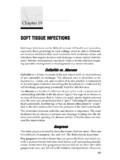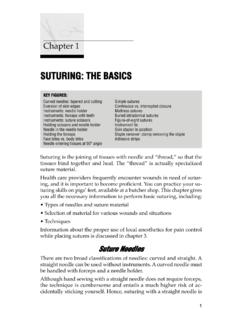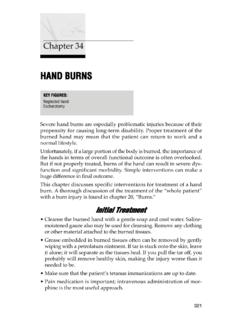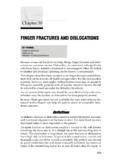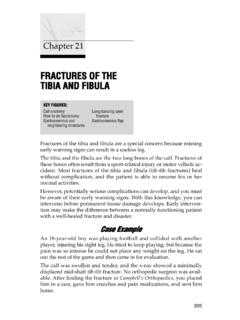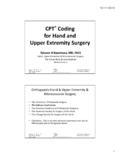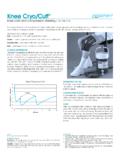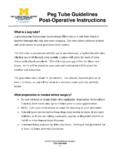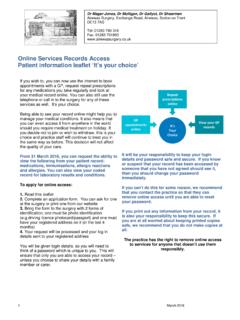Transcription of NERVE AND VASCULAR INJURIES OF THE HAND
1 Chapter 33. NERVE AND VASCULAR INJURIES . OF THE HAND. KEY FIGURES: Digital NERVE location on finger Epineurial repair Nerves and blood vessels of the hand and fingers usually are quite del- icate, and some are quite small. Optimal repair of INJURIES often re- quires the microsurgical expertise of a reconstructive surgeon. However, an understanding of basic principles is useful when you find yourself without specialist support. NERVE INJURIES NERVE Physiology When a NERVE is cut, the distal part of the NERVE slowly dies and cannot regrow. The proximal part of the NERVE will regenerate. However, without proper treatment, there is no guarantee that the NERVE will grow correctly or that function (sensory or motor) will be restored.
2 The NERVE laceration should be repaired by sewing the cut ends to- gether. Repair increases the likelihood that the living proximal part will grow in the proper direction, along the path left by the disintegrat- ing distal part. Nerves grow at a rate of 1 mm/day once the reparative process begins (usually within a few weeks of injury). Remind the patient that even if the NERVE is repaired, normal sensation and movement will not be apparent immediately after the procedure. It will take many months to know the final outcome. 313. 314 Practical Plastic Surgery for Nonsurgeons General NERVE Anatomy Nerves are made up of axonal fibers running in parallel.
3 These fibers are surrounded by loose connective tissue, called epineurium. In larger nerves that have many different axons (some sensory, some motor in function), the connective tissue between the individual axons is called perineurium. Sutures should be placed in the loose connec- tive tissue around the axons, not in the axonal substance itself. Digital Nerves Digital nerves are approximately 2 3 mm in diameter. They run with the digital arteries along the sides of each finger. If you look at your Determining the position of the digital NERVE . A, Flex the finger and mark the most dorsal aspect of both PIP and DIP flexion creases with a dot.
4 Connect the dots in a straight line. B, The course of the digital NERVE is illustrated by the dashed line. NERVE and VASCULAR INJURIES of the Hand 315. finger from the side and completely flex the distal (DIP) and proximal interphalangeal (PIP) joints, the neurovascular bundle runs along a line that connects the flexion creases of these joints. Digital nerves are purely sensory. If a digital NERVE is cut, the patient feels numbness on the corresponding side of the finger. Motor function in the finger should be normal, because it is controlled by the tendons, whose muscles are innervated more proximally in the forearm. Impairment of motor function (other than pain with movement) sug- gests that tendon injury also is present.
5 Injury to a digital NERVE at any point proximal to the DIP flexion crease should be repaired. In the fingertip (distal to the DIP flexion crease), the NERVE divides into its terminal branches, which are too small to repair. With distal NERVE INJURIES , sensation may return without formal NERVE repair. Larger Nerves Nerves in the forearm and wrist ( , median and ulnar nerves at the wrist) are much larger than digital nerves; their diameters range from 5 10 mm. Most have both motor and sensory functions. When you look at the cut ends of the NERVE , especially under magnification, you can see that the inner NERVE fibers are of various diameters and that some fibers seem to be grouped together within the NERVE .
6 For optimal outcome, the proximal sensory fibers should be sutured to the distal sensory fibers and the proximal motor fibers to the distal motor fibers. Specialists sometimes repair larger nerves with electo- physiologic guidance. This technique uses electric stimulators to iden- tify which fibers are sensory and which are motor. Thus, the surgeon can determine exactly which fibers should go together. However, this specialized equipment usually is found only in high-technology hand centers. Your best strategy is to try to align the NERVE , using whatever land- marks you can discern. For example, try to line up the tiny blood ves- sels in the connective tissue around the NERVE and fibers of similar size.
7 NERVE Repair For optimal results, use at least twofold magnification (glasses or mi- croscope). The more magnification, the better. Twofold magnification glasses make the image appear twice as large as with the naked eye. Use the most delicate instruments you have jewelers forceps, fine needle holders, fine scissors and the smallest needle you can find (8-0. or 9-0 nylon is best). 316 Practical Plastic Surgery for Nonsurgeons Epineurial repair. Sutures are placed in the connective tissue surrounding the NERVE fibers. (From McCarthy JV (ed): Plastic Surgery. Philadelphia, Saunders, 1990, with permission.). Place your sutures in the epineurium, not in the NERVE fibers.
8 This ap- proach aligns the NERVE fibers and allows proper growth. There should be no tension on the repair. You may need to free the NERVE from the surrounding soft tissues to remove tension. You also can change the position of the patient's fingers or wrist to allow the ends to meet more easily. Caution: if you bend the finger or wrist during surgery to bring the NERVE ends together, it must stay in this po- sition for 10 14 days. If you accidentally straighten the hand in the op- erating room, you will disrupt the repair. If you have no magnification and minimal instruments: For a digital NERVE , place a single simple suture to bring the ends together.
9 For a larger NERVE , 3 4 sutures should be placed. If you have magnification and very small sutures (8-0 or 9-0): For a digital NERVE , place 2 4 simple sutures to bring the ends together. For larger nerves, place as many as you need to get a smooth repair ( , NERVE fibers should not protrude from the epineurium). If there is too much tension on the NERVE repair despite different posi- tioning techniques, a NERVE graft is required. This technically challeng- ing procedure requires referral to a specialist for optimal outcome. Even so, there is no guarantee that a NERVE graft will work. To facilitate future exploration and NERVE grafting, mark the ends of the NERVE by placing a 4-0 or 5-0 nylon or prolene simple suture in the epineurium.
10 Be sure to use a nonabsorbable material, which helps to locate the NERVE ends at the next operation. The surgeon performing the subse- quent procedure will be grateful. NERVE and VASCULAR INJURIES of the Hand 317. Postoperative Care The repair should be immobilized by splinting the hand or finger for a minimum of 10 14 days. If the finger or hand required special positioning to get the NERVE ends to meet during the operation, the patient should begin to open the finger or hand slowly (over the subsequent 1 2 weeks) to avoid dis- ruption of the repair. If a motor NERVE is injured, the patient should move the joints of the hand regularly to prevent stiffness.
